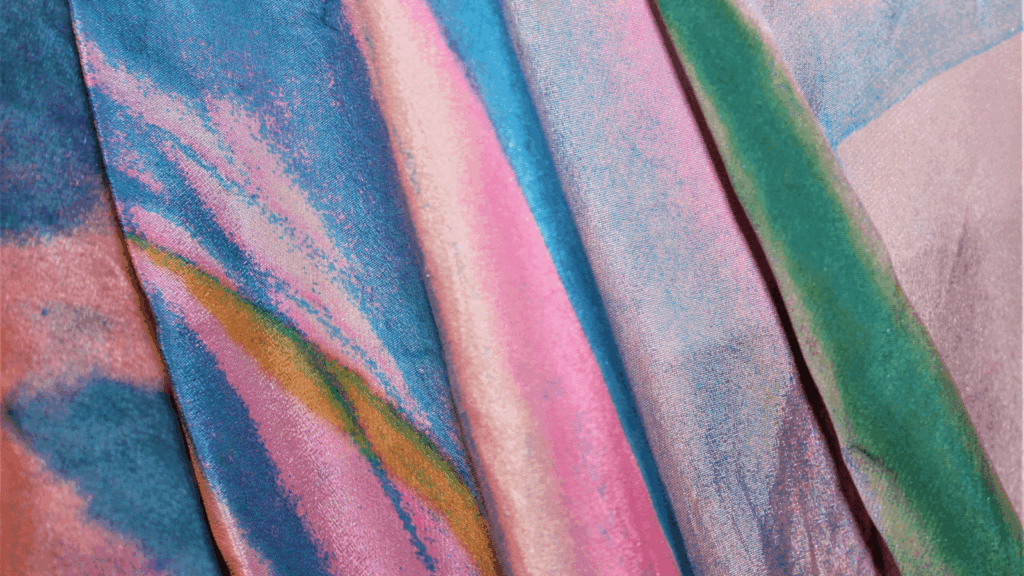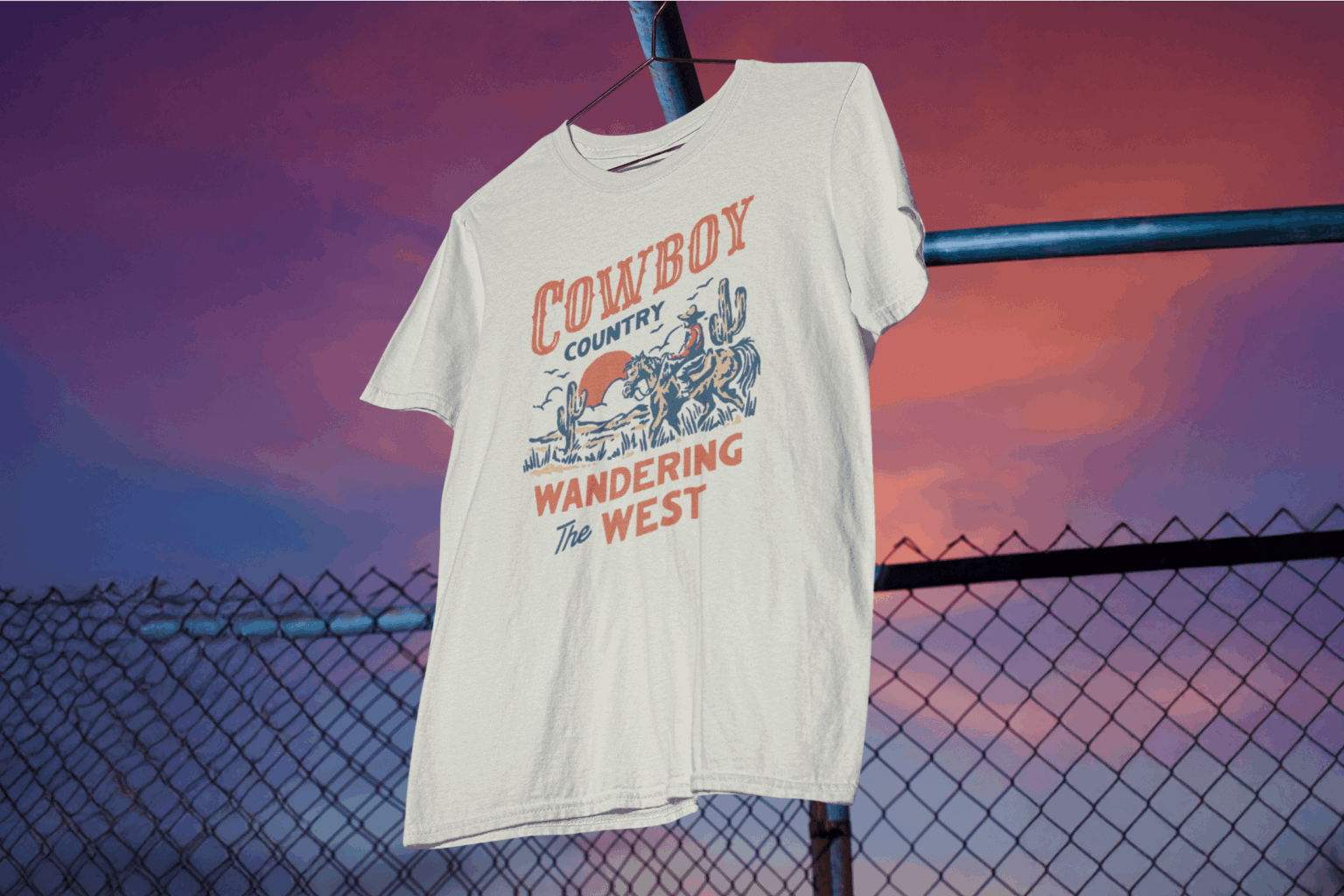Make your own shirt today
How much does a shirt weigh? If you run an online store or a print-on-demand business, the actual weight of your product affects everything from pricing and shipping to customer satisfaction.
With the global t-shirt market set to generate $46.99 billion in revenue in 2025, understanding the details behind your products is crucial for making better business decisions.
In this guide, we’ll break down average shirt weights by type, material, and style to help you sell smarter for better profits.
Key takeaways
- A basic cotton t-shirt typically weighs 4-6 oz (113-170 g).
- Fabric type, cut, and printing method all influence t-shirt weight.
- Fabric weight is measured in GSM, oz/yd², or singles in the case of cotton shirts.
- Lightweight materials are breathable and cost less to ship. Heavyweight t-shirts are pricier but offer more warmth, structure, and a premium feel.
- Always consider t-shirt weight when setting shipping rates and product pricing.
Why t-shirt weight matters

T-shirt weight isn’t just about numbers. It impacts the comfort, printing quality, and cost of the product you’re selling.
- Comfort and breathability: Lightweight shirts are better for hot climates, while heavier ones are warmer and offer a premium feel.
- Durability: Heavier shirts tend to have more structure, usually lasting longer and holding their shape better over time.
- Style and fit: The fabric weight influences how a shirt drapes and fits. A boxy heavyweight tee looks and feels very different from a flowy lightweight shirt.
- Print quality: Certain fabrics and weights hold prints differently, affecting sharpness, color, and durability.
- Cost and pricing: Heavier shirts are usually more expensive to produce and ship, which can impact your pricing strategy and profit margins.
- Printing technique: Some methods, like sublimation, work best on lightweight polyester blends, while embroidery pairs better with thicker fabrics.
Looking for affordable items to sell? Explore our guide on custom t-shirts under $10 – with no minimum order requirements!
Factors influencing t-shirt weight

When trying to determine how much does a t-shirt weigh, it’s important to consider several factors. Even t-shirts made from the same material can have different weights depending on their cut, fabric thickness, and design details.
Here’s what impacts the overall weight of a t-shirt.
Material composition
The type of material you use can affect the weight of a t-shirt, with cotton being generally heavier than polyester.
Understanding different materials’ properties is essential for managing printing quality, shipping costs, and customer expectations.
- Cotton: A standard cotton t-shirt typically weighs between 5 to 7 ounces (140 to 200 grams), depending on thickness and size. Cotton is breathable, soft, and comfortable to wear – popular for lightweight summer tees and medium-weight shirts for cooler weather or layering.
- Polyester: T-shirts made from synthetic fibers like polyester tend to be lighter, quicker to dry, less prone to wrinkling, and durable, which is great for athletic wear.
- Blends: Many t-shirts use cotton-polyester blends, combining the softness of cotton with the moisture-wicking properties of synthetics. Depending on the combination ratio, blends can weigh slightly less than 100% cotton shirts.
Sizes and cuts
T-shirt weight increases with size. A 2XL shirt weighs more than a size S, even if they’re made from the same material.
Beyond different sizes, fitted cuts tend to weigh less than oversized or relaxed styles, so consider this when calculating shipping or packaging.
The manufacturing process and construction of the t-shirt can also impact its weight. For example, tightly woven fabrics tend to be heavier than loosely knit ones, even if they’re made from the same fiber.
Other factors that impact how much a shirt weighs overall include the type of stitching and whether it has side seams, double-needle hems, or reinforced shoulders.
Design details
Prints, tags, trims, and other design features can increase how much a shirt weighs.
For example, an all-over print or heavy ink coverage might add a few extra grams, which matters when calculating shipping costs at scale.
Measuring fabric weight

To understand how heavy a t-shirt is, it’s important to know how fabric weight is measured. This helps you choose the right fabric for your brand and compare different types, whether you’re focused on comfort, print quality, or shipping costs.
The textile industry uses a few common units to express fabric thickness and weight.
Fabric weight is typically measured in ounces per square yard (oz/yd²) or grams per square meter (GSM). Cotton t-shirts can also be measured by singles, which refers to yarn thickness.
A higher GSM or oz/yd² value indicates a denser and heavier material.
A higher singles count makes the fabric finer and lighter, while a lower singles count results in a coarser and heavier feel.
Grams per square meter (GSM)
GSM is the most widely used measurement, especially outside the US. It tells you how many grams one square meter of fabric weighs.
Lightweight t-shirts usually fall around 120-160 GSM, medium-weight t-shirts range from 160-200 GSM, and heavyweight t-shirts can go above 200 GSM.
The higher the GSM, the thicker and heavier the fabric feels.
Ounces per square yard (oz/yd²)
While it serves a similar purpose to GSM, this unit is more common among US manufacturers.
It measures the weight of one square yard of fabric in ounces, and is helpful for comparing material specs from domestic suppliers.
In general, a lightweight t-shirt is around 3.5 oz, while a heavyweight one can be 6 oz or more.
Singles
Singles measure the thickness of the yarn used to make cotton or cotton-blend tees.
A lower number means thicker threads and a heavier material. For example, a 20-singles shirt will generally feel thicker and heavier than a 30-singles shirt.
While not always listed on product pages, singles can give extra insight into fabric texture and quality.
How much does the average shirt weigh?

The average weight of a shirt varies depending on the type of t-shirt, its fabric, and any added features.
Here’s a rough guide to help you estimate what a shirt weighs before factoring in things like packaging or shipping materials.
Basic t-shirts
Basic t-shirts usually weigh between 4 to 6 ounces (113 to 170 grams). However, some standard cotton t-shirts with thicker fabric can weigh up to 210 grams.
This range makes them versatile for everyday wear and a solid choice for most print-on-demand stores.
Choosing the right base is key for print quality. Check out our roundup of the best blank t-shirts for your POD store.
Graphic tees
Graphic t-shirts generally weigh between 5 to 7 ounces (142 to 198 grams).
Aside from the added ink or layers used in the design, these shirts are slightly heavier than plain tees because they’re often made with medium to heavyweight blanks for durability.
If you use larger or full-front prints, expect the shirt to weigh slightly more overall.
Long-sleeve t-shirts and sweatshirts
Long sleeves typically weigh between 6 to 8 ounces (170 to 227 grams), while sweatshirts can weigh anywhere from 10 to 14 ounces (280 to 400 grams).
The extra fabric adds to the weight, which is important to factor in when setting shipping costs or bundling orders with other clothing items.
What are the types of t-shirts based on their fabric weight?

T-shirts are often grouped by fabric weight, which influences how they feel, wear, and what they cost to ship. Here’s how the different types compare, along with ideal use cases for each.
Lightweight t-shirts
Lightweight t-shirts typically range from 120 to 150 GSM or 3.5 to 4.5 oz/yd².
These are made from low-weight materials like ringspun cotton or polyester blends, making them breathable and soft. They’re suitable for summer, hot weather, layering, or athletic apparel.
Lightweight t-shirts are a cost-effective choice for bulk orders, promotional events, or giveaways. However, their thinner fabric may be less durable over time or feel too sheer for some customers.
Medium-weight t-shirts
Mid-weight t-shirts fall between 150 and 180 GSM or 4.5 to 5.3 oz/yd².
They provide the perfect balance between comfort and structure, making them the go-to choice for many print-on-demand sellers.
These shirts are suitable for everyday wear, brand merchandise, or seasonal collections. They handle most print methods well and feel soft without being too thin.
Heavyweight t-shirts
Heavyweight t-shirts start at 180 GSM and go up beyond 200 GSM or 5.3 to 6 oz/yd². These are made with thicker fabric, like carded cotton, and often have a more structured fit.
Heavyweight fabrics are perfect for colder weather, streetwear brands, or products that use embroidery.
The heavier material adds durability and a premium feel, which many customers associate with quality. However, they can cost more to produce and ship, and may feel too warm for hot climates.
Shipping and t-shirt weight

How much a t-shirt weighs plays a direct role in shipping costs, especially when you’re fulfilling large orders or selling internationally. Knowing the actual weight of your t-shirt helps you calculate packaging needs, estimate delivery fees, and avoid unexpected charges.
How different t-shirt weights affect shipping
Lightweight t-shirts are the most affordable to ship.
- A basic cotton t-shirt that weighs under 150 grams keeps your parcel weight low and fits well into budget shipping tiers like USPS First-Class. These are ideal if you’re offering free or flat-rate shipping, especially in competitive markets.
Medium-weight t-shirts strike a good balance between perceived quality and shipping efficiency.
- While still affordable to ship, they typically weigh 150 to 200 grams. This may push your package closer to the next shipping bracket, especially when paired with other clothing items.
Heavyweight t-shirts use thicker materials or additional design elements like embroidery.
- Usually weighing more than 200 grams, the extra weight can increase shipping costs, particularly for high-volume orders or international delivery zones where every ounce matters.
Wondering how to price your products? Our t-shirt pricing guide breaks down profit margins, cost structures, and customer expectations.
Packaging and combined orders
Don’t forget to factor in packaging. A poly mailer, product tags, or wrapping can add 20 to 50 grams to your parcel.
If you’re shipping multiple t-shirts in one order, the weight can add up quickly and push your package into a higher cost tier.
Always check your shirt weight in the Printify Catalog product details page and add a buffer when setting your shipping rates.
Want to drive conversions for your product line? Learn how to set up shipping in your Printify dashboard to keep orders running smoothly.
Why t-shirt weight matters for print quality
Choosing the right t-shirt weight is not just about comfort or shipping. It also affects how your design looks and holds up after printing.
Discover which printing methods work best with specific fabric types and thickness levels.
DTG
Direct-to-garment (DTG) printing works best on smooth, medium-weight cotton materials. Thin fabrics may soak up too much ink, while rough, heavy fabrics can create an uneven print surface.
Screen printing
Screen printing is ideal for medium to heavyweight t-shirts. Thicker fabrics handle the pressure of screen application well and keep the design sharp through multiple washes.
Sublimation
Sublimation works best on lightweight polyester blends. The ink bonds directly with the synthetic fibers, creating a long-lasting print. This method does not work on cotton materials.
Not all tees are created equal. Here’s a curated list of the best print-on-demand t-shirts based on fit, fabric, and print compatibility.
FAQ
The average t-shirt weighs between 4 to 6 ounces (113 to 170 grams), depending on the size, material, and style. A cotton t-shirt typically weighs around 5 ounces. Embroidery, long sleeves, or heavier fabrics can increase the overall weight.
T-shirt fabric weight is measured in GSM (grams per square meter) or oz/yd² (ounces per square yard). The higher the number, the thicker and heavier the material.
You might also see singles, which refer to yarn thickness and indirectly affect how a t-shirt weighs and feels.
Lightweight tees (120-150 GSM) are thin and good for hot weather.
Medium-weight t-shirts (150-180 GSM) balance comfort and durability, making them a go-to for everyday wear.
Heavyweight t-shirts (180-200+ GSM) are made with thicker fabrics, ideal for colder climates and high-end styles.
Shipping costs go up as shirts get heavier, since they add to the total package weight.
Lightweight t-shirts help keep shipping costs low, especially when offering free delivery or bulk discounts. Always factor in the material weight, shirt size, and packaging when calculating shipping fees.
Knowing the actual shirt weight helps you manage product costs, set the right shipping rates, and choose the best shirt for your printing method.
It also improves customer satisfaction by setting clear expectations for fit, feel, and quality.
Conclusion
T-shirt weight isn’t just a technical detail. It affects how your shirts feel, how they print, how much they cost to ship, and how customers perceive your brand.
From lightweight summer tees to heavyweight premium pieces, knowing the average t-shirt weight helps you make smarter business decisions for better results and higher profits.












